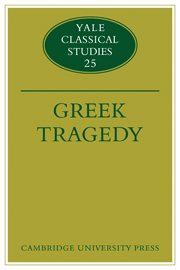Book contents
- Frontmatter
- Contents
- Introduction
- Septem contra Thebas
- The dissembling-speech of Ajax
- The tragic issue in Sophocles' Ajax
- Sophocles' Trachiniae: myth, poetry, and heroic values
- On ‘extra-dramatic’ communication of characters in Euripides
- The infanticide in Euripides' Medea
- The Medea of Euripides
- On the Heraclidae of Euripides
- Euripides' Hippolytus, or virtue rewarded
- Euripides' Heracles
- The first stasimon of Euripides' Electra
- Trojan Women and the Ganymede Ode
- The Rhesus and related matters
The Medea of Euripides
Published online by Cambridge University Press: 10 January 2011
- Frontmatter
- Contents
- Introduction
- Septem contra Thebas
- The dissembling-speech of Ajax
- The tragic issue in Sophocles' Ajax
- Sophocles' Trachiniae: myth, poetry, and heroic values
- On ‘extra-dramatic’ communication of characters in Euripides
- The infanticide in Euripides' Medea
- The Medea of Euripides
- On the Heraclidae of Euripides
- Euripides' Hippolytus, or virtue rewarded
- Euripides' Heracles
- The first stasimon of Euripides' Electra
- Trojan Women and the Ganymede Ode
- The Rhesus and related matters
Summary
In 431 b.c. Euripides competed against Sophocles and Euphorion with three tragedies, Medea, Philoctetes and Dictys, followed by a satyr play, Theristae; he was awarded the third prize.
But his Medea left a deep and lasting impression in the minds of his Athenian audience; comic parodies, literary imitations and representations in the visual arts reflect its immediate impact and show that the play lost none of its power to fascinate and repel as the centuries went by. It struck the age as new, but like all innovative masterpieces, it had its deep roots in tradition; it looks back to the past while it gropes for the future. In it we can see what Euripides took over from his predecessors and contemporaries, how he transformed what he learned from them, and what he invented and was to refine and develop as his own unique tragic vision in the last twenty years of his long dramatic career.
He had been fascinated by this story from the very beginning. His first offering in the Dionysiac contest (in 455 b.c., only three years after the staging of Aeschylus' Oresteia) included the Peliades, the story of Medea at Iolcos, her deceitful promise to rejuvenate old Pelias, its king, and the king's death at her hands.
- Type
- Chapter
- Information
- Greek Tragedy , pp. 193 - 226Publisher: Cambridge University PressPrint publication year: 1977
- 2
- Cited by



